While the Inka (Inca) are probably the best-known of the ancient civilizations of South America because they were flourishing when the Spanish arrived, there were many ancient civilizations which preceded them and provided the cultural foundations for the Inka. One of these was Moche who began to flourish about 2000 years ago.
The Moche flourished from about 1 to 700 CE on the north Peruvian desert margin between the Andes and the Pacific. Their realm extended for at least 250 miles between the Lambayeque and Nepeña Valleys. In each of the river valleys they established ceremonial centers with large platform mounds. Each of the major Moche settlements seems to have been ruled by hereditary rulers who held religious and political power. Unlike the later Inka, the Moche were not an empire, but more closely resembled city-states unified by common cultural features.
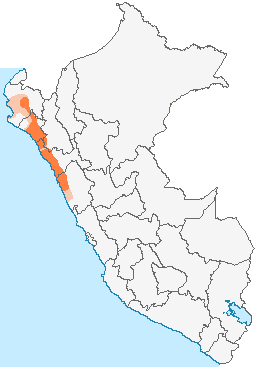
In the river valleys, they were able to transform the land into verdant oasis. The agricultural crops which they raised included beans, cotton, corn, squash, chilies, and peanuts. The fields were often fertilized with guano which they collected from islands off the coast. In order to provide water to their agricultural fields, they developed extensive irrigation networks. One canal ran for 900km.
In addition to agriculture, they also fished and hunted. They fished in the ocean using reed boats and cotton nets. They hunted deer in the valleys and hills. Their domesticated animals included the Muscovy duck and the llama. The llama served as a pack animal and as a source for wool.
Part of the Moche wealth came from their ability to exploit gold and other metal resources. The Moche were expert metal workers. They made jewelry and other ornaments of gold, silver, copper, and alloys. These were often inlaid with lapis lazuli and turquoise. In addition to using metal for ornaments, they also made metal tools, including chisels, spear points, and fishhooks.
They were also experts in ceramics and weaving. In their ceramics, they used molds to cast wonderful shapes which they then painted. Their pottery provides an interesting and realistic insight into their lives. The portrait pots are amazingly realistic portrayals of real people showing a variety of emotions. Much to the chagrin of many American museum curators, their pots sometimes show sexual acts which cannot be shown in many museums.
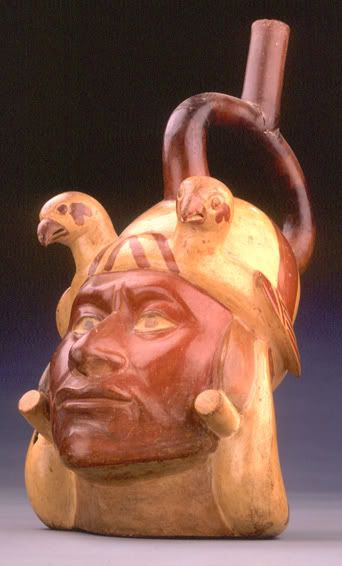
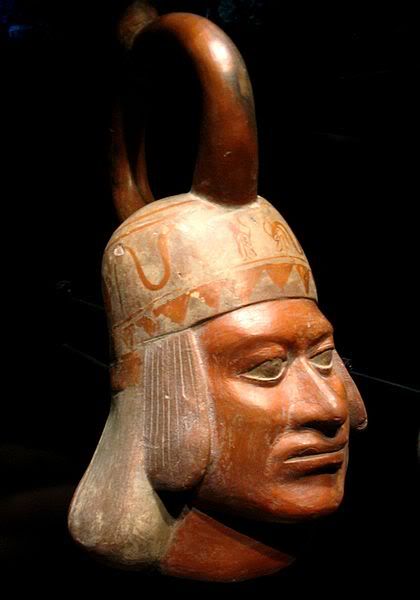
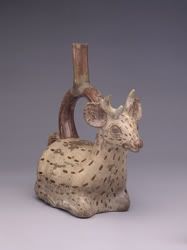
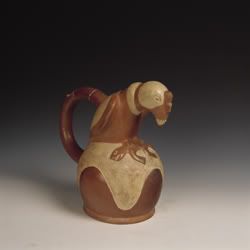
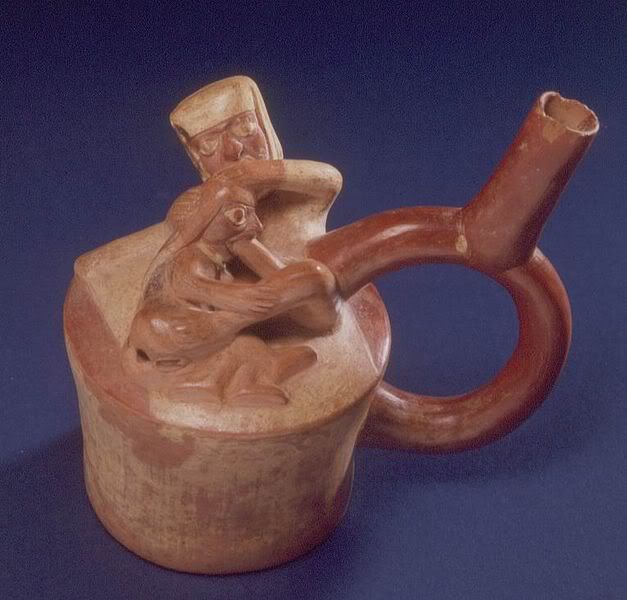
The Moche maintained a fairly elaborate trading network. Feathers from the Amazon basin in the Moche sites show that their trading connections led across the Andes and into the rainforests on the other side.
Warfare may have been an important part of Moche culture as warriors are often shown in the pottery and in the murals which lined the temples and pyramids.
Moche religion seems to have centered on ideas of dualistic opposition: gold/silver, day/night, land/sea. One of the figures that appears in their religious pantheon is the Decapitator. This god (?) is often shown as part cat (the teeth) and part octopus (the wavy tentacles) with bulging eyes and huge ear spools. His outstretched arms wield a scepter or knife in one hand and an open-mouthed severed head in the others.
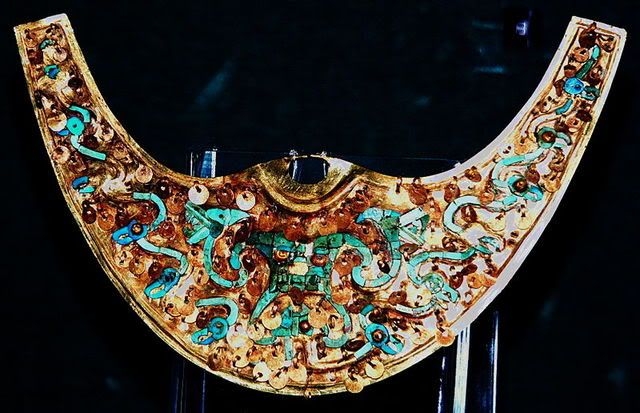
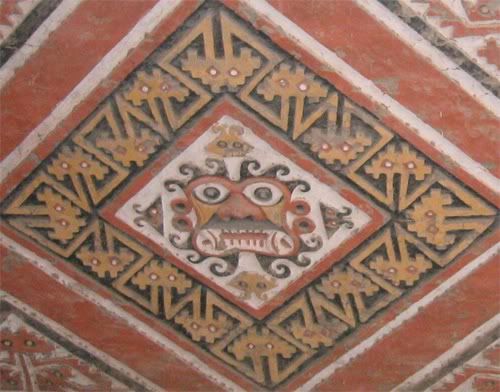
Shown above are some of the images of the Decapitator.
Other Moche deities included a goddess who wore a jester-like headdress, and a bird god. One of the principle rituals involved the drinking of blood taken from sacrificial victims. According to images from the pottery and murals, the priests would offer the blood in chalices to the gods before drinking it. By adding the juice of the ulluchu fruit to the blood it would not coagulate.
Moche monumental architecture is characterized by large adobe (mud brick) pyramids with platforms. They often decorated the pyramids and temples with friezes depicting Moche deities. Tombs of the rulers were placed inside the pyramids with elaborate ceremonies which are depicted on the Moche pottery.
Residential areas were located adjacent to the major pyramids and in the smaller towns up and down the river valleys.
One example of Moche monumental architecture is found at the El Brujo Complex, located about 4 km south of the present-day town of Trujillo, Peru. This site contains three large huacas (mounds or pyramids). One of these is the pyramid of Cao Viejo which is about 30 meters (100 feet) in height. This massive monument was built and rebuilt in four major phases between 200 and 650 CE. In each phase, the builders intentionally and carefully buried the previous temple, thus creating an even larger and higher pyramid. Each phase tended to repeat the same art and murals of the previous era.
On the lower level of the pyramid is a mural showing 10 naked men tethered together by a rope around their necks. Some archaeologists have interpreted this as an illustration of war captives, an indication that the Moche were not totally a peaceful people.
One of the major burials excavated at Cao Viejo has been named the Lady of Cao. She was a woman who died in her twenties around 400 CE. She was buried with a host of ceremonial items, including typical Moche gold jewelry and headdresses. In her grave were sewing needles, weaving spools, and raw cotton. She was also buried with weapons of war: two ceremonial clubs and 23 spears. Was she a warrior?
The well-preserved mummy of the Lady of Cao reveals that she had complex tattoos of spiders, seahorses, and snakes which covered her arms. The tattoo designs are distinct from the usual Moche designs. Skeletal analysis shows that she gave birth at least once. Beside her a teenaged girl had been sacrificed by strangulation.
The Temple (Pyramid) of the Sun (Huaca del Sol) at the El Brujo Complex is a stepped pyramid about 40 meters (130 feet) in height and about 350 meters (1,150 feet) in length. It is the tallest adobe structure in the Americas. It has four major platforms and was erected about 600 CE using an estimated 50 million adobe bricks.
The Spanish later mined the Temple of the Sun for its gold and silver objects which they melted down into bars. During this process they destroyed about two-thirds of the pyramid.
The third huaca at the El Brujo Complex is the Temple of the Moon (Huaca de la Luna). This large mound has three platforms and was built in five construction phases between 300 and 600. Its base is 300 meters by 250 meters. There are at least 70 sacrifices within the Huaca: all are adult males with their throats cut. Many have broken arm and hand bones. The pathology suggests the men died fighting: their arms hold crushed shields, their fingers broken with maces. While this seems to suggest actual combat, DNA tests show that the men were related to the people living in the city. Thus, they were not invading warriors.

The Huaca de la Luna is shown above.
The demise of the Moche was brought about by a Mega El Niño that led to 30 years of intense rain followed by 30 years of drought.
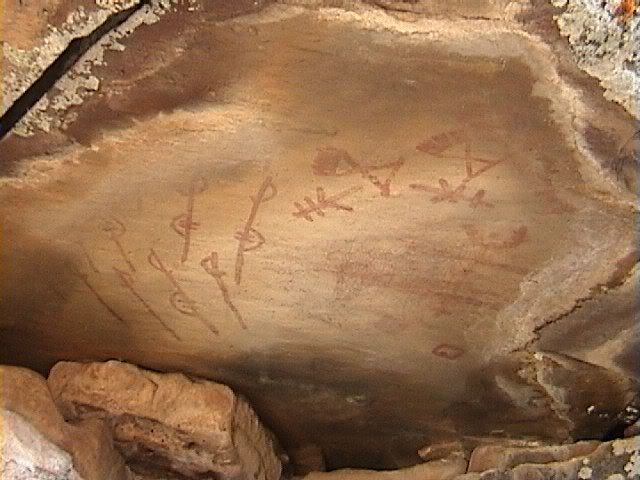
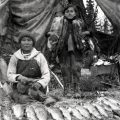
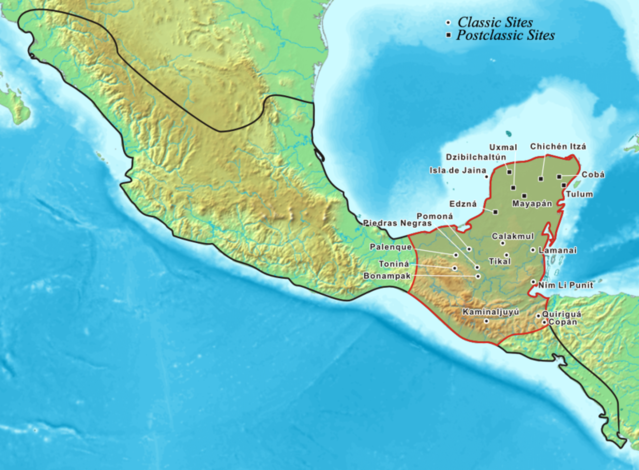
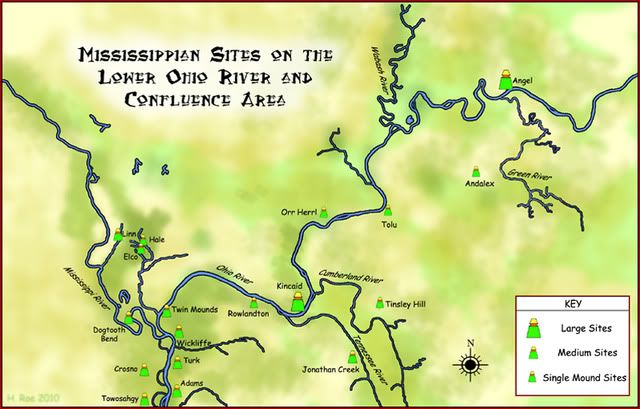
Leave a Reply